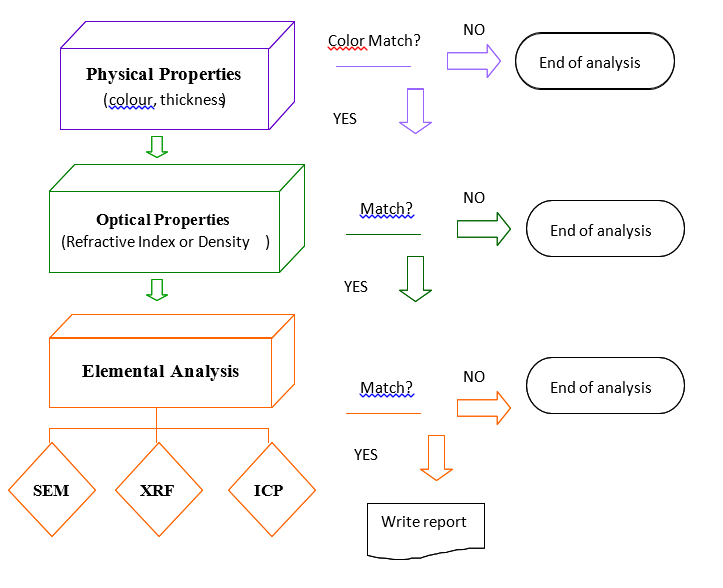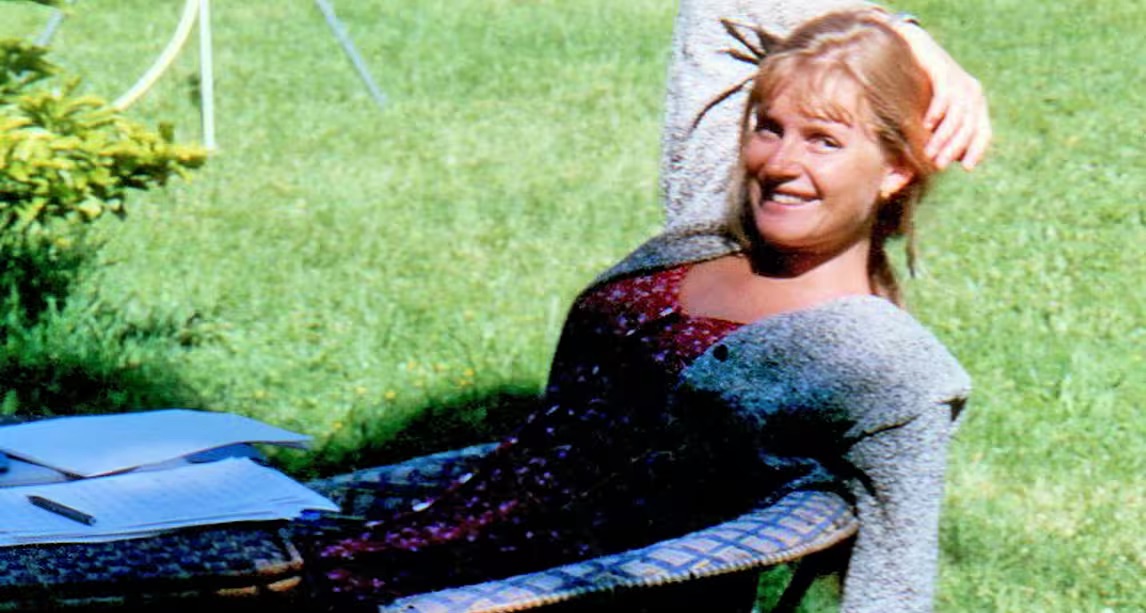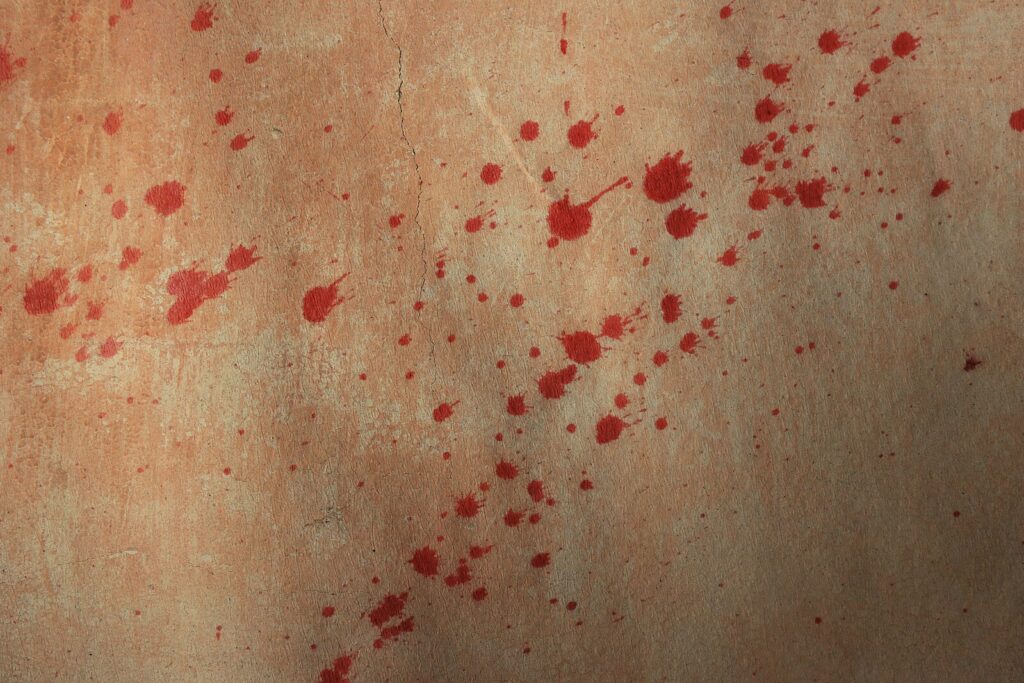Now Reading: Forensic analysis of glass evidence: Past, Present and Future
-
01
Forensic analysis of glass evidence: Past, Present and Future
Forensic analysis of glass evidence: Past, Present and Future
Introduction
Glass is the most frequently occurring transfer evidence found at crime scenes. Generally, it is encountered in scenes involving burglary, hit and run, shooting scenes and housebreaking and theft etc. Broken glass is easily transferred to objects and individuals present at the scene of crime, thus it is possible to link a suspect to the event and the items as well as to the individuals present at crime scene [1]. Glass analysis mainly involves classification, discrimination and individualization of the glass evidence [2]. Classification can also be called identification. As different kinds of evidence samples may be encountered at the same crime scene it is important to identify the exact source of that evidence sample. Discrimination comes after classification, as it excludes the evidence if it does not match the source. Individualization is a determination process that every sample is unique even among other samples of same class. According to the law of individuality, every evidence sample have unique characteristics that differentiate it from the class of evidence. Physical matching is the only method of glass individualization. Physical matching of the known broken sample fragments with the questioned sample enables the individualization of glass evidence and eliminates all other sources [2]. In case if physical matching is not possible then other methods of analysis are performed. Other forensic analysis of glass consists of comparison of various physical properties, optical properties and elemental analysis techniques [3].
History of forensic analysis of glass evidence
Various kinds of glass evidences can be encountered at the crime scene such as small glass fragments, broken glass pieces, window planes, headlights, etc. Every glass has different composition and that plays important role in the forensic analysis of glass. Glass has different kinds of fractures and forensic analysis can determine the direction of glass fracture. Early forensic analysis includes physical techniques, microscopic techniques and elemental analysis.
Physical examination: Every glass analysis starts with identification of the glass by physical and optical properties such as amorphous structure and isotropism, hardness. Initial stages of analysis involve physical observation such as colour, surface feature, fluorescence and thickness of the glass sample. Physical examination plays important role in the comparison process of glass evidence recovered from the scene of crime and the questioned sample [4].
Basic schematic diagram for glass analysis
Density and refractive index measurements are conventional methods that were first used in glass analysis. Most forensic science laboratories use Sink-float method to determine density. In this method, a questioned glass fragment is dropped into a liquid mixture of bromobenzene and bromoform. If the glass density matches the liquid mixture density, the glass fragment neutrally floats in the liquid mixture. This method had some demerits, thus an alternative method for the determination of density is derived which is based on Stoke’s law [5].
Refractive index (RI) has been determined by immersion method in the initial years of forensic glass analysis. This method of determining RI was based on the technique described by Winchell and Emmons in 1926. This method involves, a glass fragment being immersed in a suitable oil and then heating until the glass observed under a microscope disappeared. At this temperature refractive index of both oil and glass fragments is the same [3].
Microscopic techniques re used for the preliminary examination of surface features of glass fragments. Light microscopes and stereo-microscopes are used widely for this purpose. Light microscopes are used to identify the layers of glass fracture. Glass fragments are first visually examined under fibre optical light and then observed under stereo-microscope [6].
Elemental analysis is the confirmatory examination for determining the chemical texture of glass evidence. Most of the elemental analysis are destructive in nature. Elemental analysis includes neutron activation analysis, atomic absorption spectroscopy, scanning electron microscopy (SEM), inductive coupled plasma spectroscopy (ICP), etc.
which were primarily used in the initial days of glass analysis.
Present day forensic analysis of glass
Basic steps of forensic glass analysis are same in the present day as well. Parameters of glass examination are same only the methods of examination are evolved. Physical matching or jig-saw method is still in use. Measurement of density is reduced in present days due to its limitations but still, it performed in some of the laboratories [2]. Density gradient tube filled with liquid has been discovered for the determination of density. Method of determination of refractive index has been evolved in the new era. Glass refractive index measurement (GRIM) is an automated system for determining refractive index using the immersion method. Emmons procedure has been developed for the determination of refractive index. This method uses a hot-stage microscope in association with different source lamps [1][7]. Microscopic advancement has been increased in recent years which helps in the preliminary examination of glass evidence. Elemental analysis has highly emerged in the present day. Nowadays scanning electron microscopy in conjugation with energy dispersive x-ray spectroscopy (SEM-EDX) is primarily used for elemental analysis of glass [8]. Conventional method inductive coupled plasma (ICP) spectroscopy has some disadvantages and to overcome these disadvantages ICP is coupled with optical emission spectroscopy (OES) [ICP-OES], and ICP-OS is also coupled with mass spectroscopy [ICP-OES-MS] for better result [2][9]. Laser ablation inductive coupled plasma mass spectroscopy [LA-ICP-MS] has been discovered for the detailed elemental analysis of glass [10].
Future forensic analysis of glass
According to the present scenario, the glass industry is manufacturing advanced glasses which will need more advanced techniques for glass analysis. Glass manufacture process has been evolved over the last few years. Conventional glass composition varies with modern-day glass composition. As with changing and emerging composition of glass, method of its elemental analysis is also emerging. In the future glass analysis will not be limited to present-day technologies. Researches in the field of elemental analysis are witnessing new advancement like total reflection x-ray fluorescence (TRXRF), scanning electron microscopy x-ray (SEM-XRDF) diffraction techniques, etc. [2].
Case study: Susan Nutt (1987)
In February 1987, Craig Elliott Kalani 19-year old killed in a hit-and-run case. He went for a night walk along with his dog in his neighbourhood in northwest Oregon at 9:30 PM, but never returned to his home. As the investigation proceed police found some glass pieces near his body and some of the glass fragments in Craig’s pocket.
After the collection of glass fragments, police started to search a vehicle that had damages consistent with a hit and run case. They found a car with a similar kind of damages to a woman named Susan Nutt. In order to connect Susan to the crime, it was needed to match those damages of the car to the glass fragments found at crime scene. During forensic analysis, analyst found that the glass fragments from the crime scene matched the Susan’s car damages in a preliminary examination i.e., Physical match. During elemental analysis, analyst found that windshield glass from the crime scene and Susan’s car contained the same 22 chemical elements. And that concluded that the glass fragments found at the crime scene belonged to Susan’s car.
The glass evidence helped to convict Susan Nutt. She was sentenced to up to five years in prison and five years in probation.
Conclusion
Glass has been used as evidence in criminalistics for over a century and its evidentiary value is still increasing day by day. The face of forensic analysis of glass has been changing over recent years due to advances in the identification of physical matching, physical and optical properties and elemental analysis. Advancement in forensic glass analysis has been reached the next level in the modern era and it will keep enhancing in upcoming years.
References
- Forensic glass analysis James E. Girard – Criminalistics: forensic science, crime and terrorism 2nd 97-112
- The forensic analysis of glass evidence: past, present, and future BW Kammrath, AC Koutrako – Forensic Science: A multidisciplinary approach, 2016 – books.google.com 299-329.
- Elemental analysis of glass and paint materials by laser ablation inductively coupled plasma mass spectrometry (LA-ICP-MS) for forensic application Tatiana Trejos, Waleska Castro, Jose r. Almirall October 2010 – 17-19.
- Forensic Glass Comparison: Background Information Used in Data Interpretation Maureen C. Bottrell April 2009 vol 2 no. 2. (https://archives.fbi.gov/archives/about-us/lab/forensic-science-communications/fsc/april2009/review).
- Density determination of irregular shaped and small glass fragments by Stoke’s law: An alternative technique for the forensic analysis of glass Panadda, C. Ratchapak and P. Nathinee 2018.
- Microscopic analysis methods https://www.contractpharma.com/issues/2014-10-01/view_features/using-microscopical-analysis-methods/ (Last accessed on 24-10-2021)
- Forensic classification of glass employing refractive index measurement Umi K. Ahmad, Nur F. Asmuje, Roliana Ibrahim, Nor U. Kamaruzaman. Malaysian journal of Forensic Science 2012, 3(1).
- A Review of Scanning Electron Microscopy Investigations in Tellurite Glass Systems Ali E. Ersundu, Miray Celikbilek, Suheyla Aydm 2012.
- Analysis of major elements in glass sample with a sequential ICP- OES Jobin Yvon S.A.S Horiba Group, Longjumeau, France.
- 10 modern technologies in forensic science https://www.forensicscolleges.com/blog/resources/10-modern-forensic-science-technologies (Last accessed on 24-10-2021)
- Forensic glass analysis by LA-ICP-MS: assessing the feasibility of correlating windshield composition and suppler Abbegayle J. Dodds, Edward M. “Chip” Pollock, Donald P. Land October 2010.
- https://prezi.com/fj2a8w7v6fbu/craig-elliott-kalani-hit-run/ (Last accessed on 29th October 2021).










